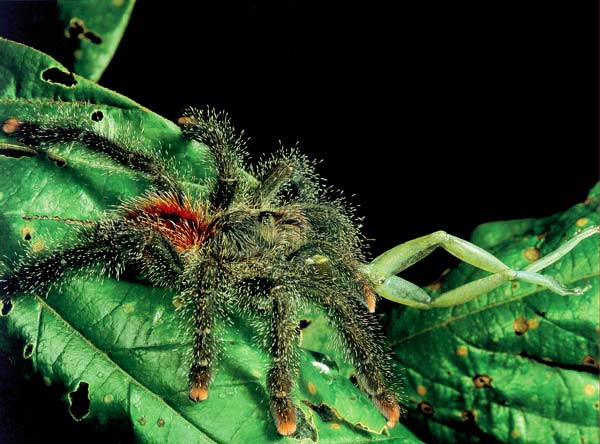
Some species of spider can catch frogs, rabbits, and even birds with their powerful poisons and special fangs.
We know that spiders are "engineers," making webs, those wonders of architecture and engineering. They are also killing machines, preparing mechanical traps, capable of building nests under water, hunting their prey with lassoos from their webs, capable of giving off chemical poisons, holding on to a thread and jumping from hundreds of times their own height, creating threads stronger than steel within their own bodies, and camouflaging themselves for hunting. We come across further miracles when we examine the structure of their bodies, alongside the properties they possess.
There are many features in all spiders' bodies bearing witness to their having been created, such as combs working like a weaving factory, laboratories making chemical products, organs producing very strong digestive properties, senses capable of perceiving the slightest vibration, strong fangs capable of injecting venom, and so on. Considering all of these properties, the spider gives the lie to the theory of evolution and once again destroys such a derisory hypothesis as coincidence.
Let us examine the organs in the spider and their features.
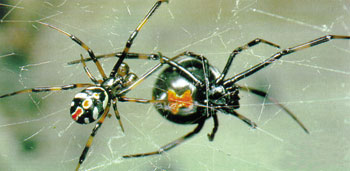 Spiders are very sensitive to vibrations on their webs. The female Black widow spider is able to tell whether the source of the vibrations on its web is an insect caught on it, or a male coming to mate. |  For a spider to build a web like the one above, there must be combs functioning like a weaving factory, a laboratory producing chemical materials, and many more complex organs in its body. Spiders, which have all of these, without exception, and the relevant characteristics, give the lie to the claims of evolution and bear witness to God's perfect creation. |
The spider's body is composed basically of two parts, the combined head and thorax (cephalothorax), and the abdomen. The head and thorax have eight eyes, eight legs, two venom fangs and two feelers. At the tip, the soft and elastic abdomen are spinnerets and holes for breathing systems. The cephalothorax and the abdomen are joined by a small stalk called the "pedicel." No other living creature's waist is as thin as the spider's. Through this narrower than 1mm stalk pass the digestive tract, veins, windpipe, and nervous system. To put it more generally, there is a special linear system joining the two halves of the spider's body. These lines form a link between the splendid mechanisms within the structure of the spider's body (venom glands, silk-producing glands, the whole body's nervous system, breathing and circulation systems) and the brain.
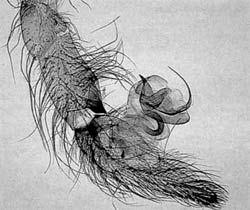
An enlarged photograph of the sensitive hairs on the spider's legs.
The spider has four pairs of legs enabling it to walk and climb even under the most difficult conditions. Each leg consists of seven parts. At the end of each leg are hairs called "scopula." Thanks to these the spider is able to walk on walls or even upside down.
The special construction of spiders' legs does not stop with allowing it to walk on non-flat surfaces. Despite the fact that their eyes do not see well, the spiders' ability to move about comfortably at night is due to the construction of their legs. Some species of spider can only sense light, or in other words possess only 10 percent of the sight of a human being. But despite this, spiders spin their webs at night and move about easily on them at the same time.
Spiders move about without treading on the sticky parts of the web, only the dry parts. They owe the fact that they are able to escape without getting caught, on the rare occasions that they tread on the sticky parts, to the fact that their feet are coated with a special liquid from their glands. The ends of the combs are known as spinnerets, each of which is covered with hundreds of spigots. The liquid silk produced by the glands in its abdomen is pushed out of the body by these nozzles and then spun in the form of silk.
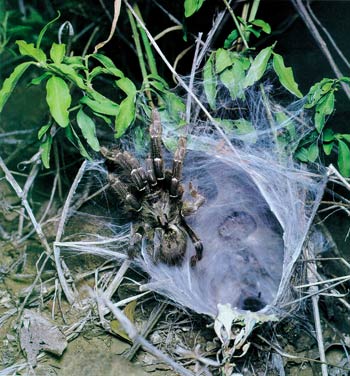
One of the spiders known for the most effective use of the vibration-transmitting properties of its web is the monkey spider, or funnel-web spider
With the exception of jumping spiders, most spiders have rather poor sight, and can only see for short distances. This disability, which might be a great disadvantage for a hunter, is compensated for by the spider's particularly sensitive early warning system.
This warning system is based upon the sense of touch. The body is covered with hairs which are very sensitive to vibration. Each one of these hairs is attached to a nerve ending. Vibrations resulting from touch, or even sound and smell, stimulate these hairs. The trembling of the hairs activates the nerve endings. The nerves then rapidly transmit the message to the brain. In this way spiders become aware of even the smallest vibration.
Spiders cannot perceive motionless prey, but by deciphering the vibrations given off by living things, they can work out where the insects are on the web. If the spider is not entirely certain where on the web the insect is, it establishes where the insect has landed by putting its legs on the web, tapping it and making it sway. From the resulting vibrations it can then locate its prey.
The spider's legs are the organs best endowed with these sensory hairs. The hairs are hollow, and of rigid construction. The animal can sense the origin of the vibrations emanating from a source of noise up to a metre away. Furthermore, there is another sensory system sensitive to temperature in the hairs on its legs. Then there are bald spots on the surface of its body with enormously sensitive nerve endings inside. On account of all these properties, spiders can sense any movement going on around them or the approach of any body, even on their own skin.
If a spider loses a leg, it grows a replacement a while later. The new leg will be shorter than the original one. The spider will not use this leg, which does not even touch the ground, for walking. In fact, the spider can walk quite comfortably with only half its original complement of legs, namely four. The only reason for another leg to grow, albeit a short one, is that the spider has need of the sensory hairs on it.
Spiders' sensitivity to vibrations on their webs is so well developed that they can tell whether the source is prey caught on the web or a male spider coming to mate.
Until a few years ago, it was thought that webs, because of their elastic construction, could not transmit vibrations. But research, using the newly developed machines called the "Doppler Laser Vibrometry," shows that the situation is quite the opposite. It is now known that webs conduct vibrations, despite their elastic construction, and that they increase the level of the vibration.32 However, no scientific reason for this has yet been discovered.
The spider can very clearly perceive any kind of warning, from a tiny sound wave to vibrations on its web. This extremely useful early warning system which passes over the web, is a mechanism having the most useful characteristics from the point of view of the spider. If we consider the fact that each one of the thousands of hairs on the spider's body is attached to a nerve ending and thence to the brain and that the spider can rapidly evaluate the warning signals it receives, the complexity of the system will become more apparent.
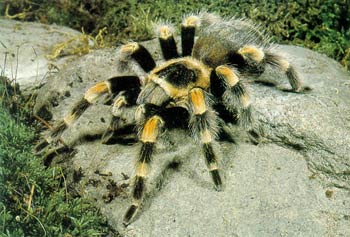 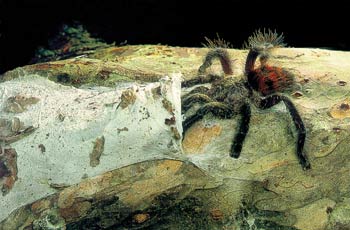 The body of the tarantula is covered in hairs which work like an early warning system. These hairs are so sensitive that they can even perceive vibrations in the air set up by sound. (top) By day this tarantula lives in the sleeping bag-shaped web it has spun. At night it leaves the web which camouflages it and goes hunting. (bottom) | 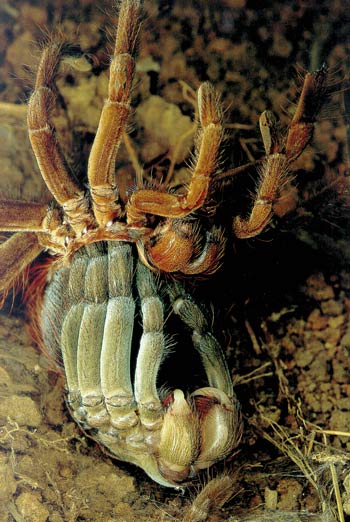 When their shells become too narrow for their growing bodies, so tarantulas have to get rid of them. Adult tarantulas grow out of their rigid skin about once a year, rolling over and struggling for hours, like a hand trying to wriggle free of a tight-fitting glove. When the shell-shedding process is completed, the spider is renewed together with all its systems and has a new shell with the same properties as the old one. |
The spider has two powerful fangs in front of its eyes. These fangs are weapons the spider uses for hunting and for protection. Behind each fang is a venom gland which pours its lethal poison into a poison hook. When the spider wishes to immobilise its prey, it sinks its fangs into it. Then it pumps venom into its victim's body through holes in its fangs.
Spiders also use these fearsome, deadly tools for building their nests and carrying small objects. To the side of the fangs are two extensions, instead of antennae, called pedipalps (feelers). The spider uses these to examine the victim it has caught in its web.
As we have seen, spiders' sensory systems are of a very special design. It is clear that this system invalidates the claim of the theory evolution of development over time. Alongside this, it is impossible to explain the existence of systems whereby the spider produces lethal poison within its own body by coincidence.
The venom's chemical make-up allows it to kill insects. In order that it should not harm the spider, the venom is stored in a specially insulated area. In the same way the spider's fangs are extremely functional. The venom-pumping mechanisms being located inside the tissue-cutting fangs allows the transfer of the venom into the victim. In this way the fangs work like a chemical, as well as a physical weapon. This demonstrates once again that every part of the spider's body has special planning, which cannot be explained by coincidences, mutations, or any other imaginary evolutionary mechanism.
The spider, together with all its properties, was created by God. All these properties are evidence for us of God's art.

The spider's fangs.
The spider completely wraps the animals which get caught in the web in another thread, which it produces after they become well stuck to the web. Then it takes the prey in its fangs and fills it full of venom, killing it.
The spider can only digest liquids. Tiny particles larger than one-thousandth of a millimetre are filtered out by hairs around its mouth. So, it is necessary for the spider to liquefy this creatures' tissues before it can digest them. For this reason the spider pulls apart the insect's tissues with digestive enzymes. Once the tissues have become fluid enough, it takes in the liquid thanks to its very strong sucking system. For example, after killing a bee, the Misumenoides Formosiges spider opens two holes, one in its head or neck, the other in its abdomen. Then it sucks the juices in the bee's body up through these holes.
The spider mixes the tissues it has sucked up with the digestive juices in its body. When the force of vacuum in the victim's body grows greater than the spider's sucking power, the spider relaxes the sucking muscles around its stomach. This allows some of the digestive juices within the spider's body to enter different parts of the bee's body, where they dissolve the tissues there too. Then the spider sucks through the other hole in its abdomen. The rotation continues until the bee is completely emptied. Beyond simply being a source of food for the spider, the bee's body becomes part of the spider's digestive system, a temporary extension of it. Finally the bee comes to resemble an empty egg shell; nothing remains of it but a shell.
Insects are not spiders' only prey. Frogs, mice, fish, snakes, or small birds can all fall victim to spiders. Spiders known as "bird spiders" are even powerful enough to catch and digest rabbits and chickens.
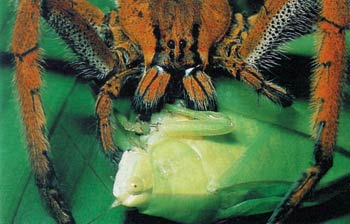 Tarantulas kill their prey by paralysing it. | 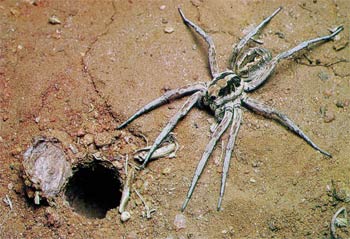 Spiders can resist hunger for long periods of time. For example, the life-span of the wolf spider is about 305 days. It can spend 208 of these without eating anything. It is able to resist hunger in this way by reducing its bodily metabolism to 1/40. Following such a period the body-weight of the spider that hunts can increase by up to double. This comes about due to the fact that their bodies were created to adapt to extreme conditions. |
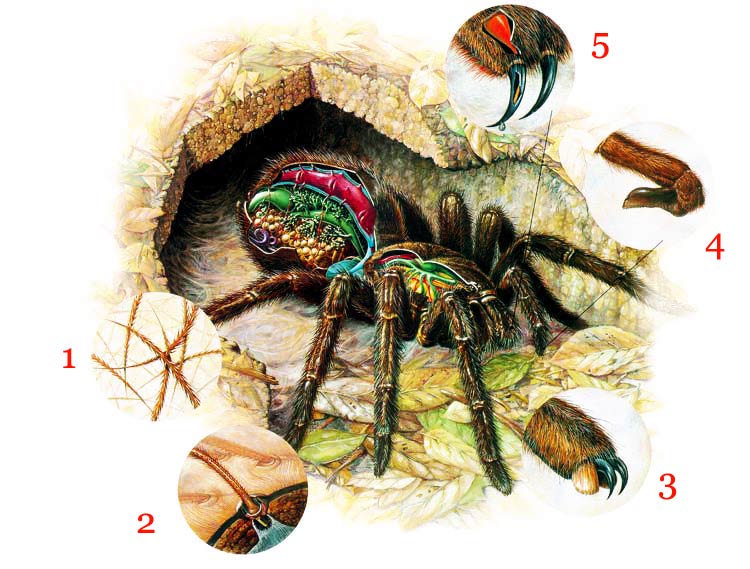
(1) DEFENCE SYSTEM
Defence System With a flick of a hind leg, tarantulas defend themselves by launching tiny hairs bristling with microscopic barbs. Once imbedded in the attacker's skin or eyes, the barbs cause a maddening itch that can persist for months.
(2) EARLY WARNING SYSTEM
Sensitive to the slightest vibration or wind, pivoting hair follicles on the tarantula's feet and lower legs alert it to approaching danger. Thanks to this feature the tarantula is able to be aware of everything going on around it. This warning system is vital, because it is the only way the spider, which is practically blind, can perceive the world around it.
(3) LITTLE CAT'S FEET
Flanked by protective tufts, needle-sharp retractable claws enable tarantulas to climb walls. Underneath, velvety pads of hair cushion the weight of the spider Ð and create eight buoyant pontoons that enable some tarantulas to walk on water
(4) MALE DELIVERY SYSTEM
Male tarantulas are equipped with specialized palps, hook-shaped appendages on the short feeding arms near the mouth. When ready to mate, males weave a web and deposit a drop of sperm on it. The sperm is then drawn up into the bulb-shaped tips of the palps, which deposit it into the female.
(5) VENOMOUS MESSAGE
Hollow fangs deliver venom produced in adjacent tiny bulbs. This poison is powerful enough to be able to kill animals such as birds, lizards, and rabbits.
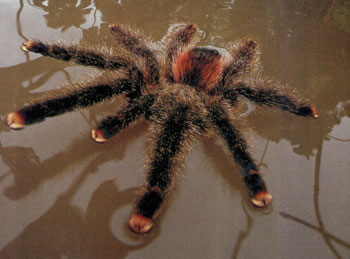
Water spiders use the surface of the water like a web for hunting, thanks to the waterproof nature of their feet. Every living thing was created by God to possess the properties it needs.
Water-spiders possess a special structure allowing them to walk on water. These spiders have a thick, velvety plait consisting of hairs covered in a water-resistant wax on the ends of their feet. This allows the spider to walk on water without sinking. The spider's ability to remain on the surface of the water is so high that, even if it were 25 times heavier than it is, it would still comfortably be able to walk on the water.
While walking on the surface of the water, water-spiders use their rear legs as rudders. Their middle legs enable them to move, while the job of the shorter front legs is to catch their prey. Water-spiders move so quickly that they can suddenly make a leap of a metre on the surface of the water. This means they move at the speed of a motor-boat.
When hunting, the water-spider uses the surface of the water like a web. A dragonfly, fly, or butterfly which falls on to the water as the result of a faulty manoeuvre becomes an ideal prey for this species of spider. When these insects' wings come into contact with the water, they become trapped on the surface of the water, as if on fly-paper. The faintest vibration they make on the surface of the water is then sensed by the spider. Furthermore, the spider is not only able to establish the prey's location through these vibrations, but also its size. It immediately goes to where its prey is stuck on the water, bites, poisons, and kills it.
Who made this coating on the hairs on a spider's feet to stop it from sinking, one wonders? This question can be broadened by thinking that every water-spider there has ever been has had its feet coated in this way. How do the spiders know about the water being able to keep them afloat, the properties of water-resistant molecules and their reaction with water molecules? Since they could not have planned this system themselves, who did? Since this planned system based on water surface tension could not have come about by itself, or by chance, how did it come about? And how did spiders pass on this system and the chemical formula of the product that keeps them from sinking to later generations of spiders?
The answers to these questions will bring us to the existence of a perfect creation. The spiders were created in perfect form by God. In the same way as God gave every species the properties it would need, he gave these spiders the feature of being able to walk on water, which they would need.
32- Bilim ve Teknik Görsel Bilim ve Teknik Ansiklopedisi (Science and Technology Gorsel Science and Technology Encyclopedia), p. 1088